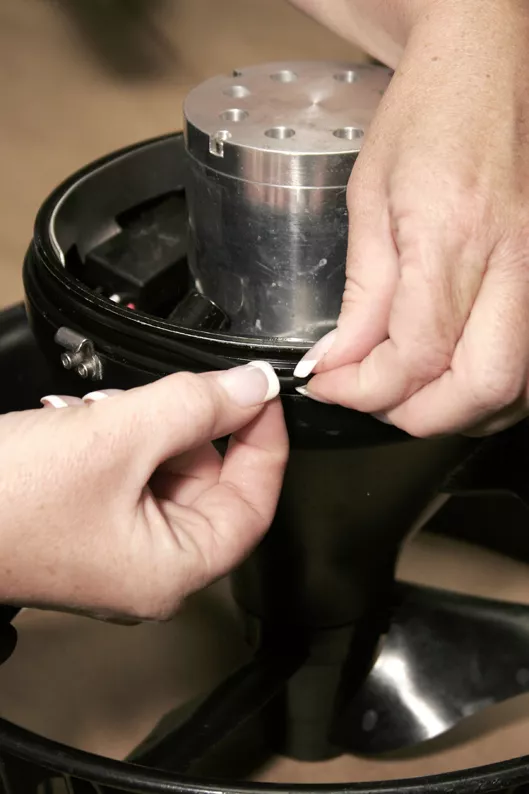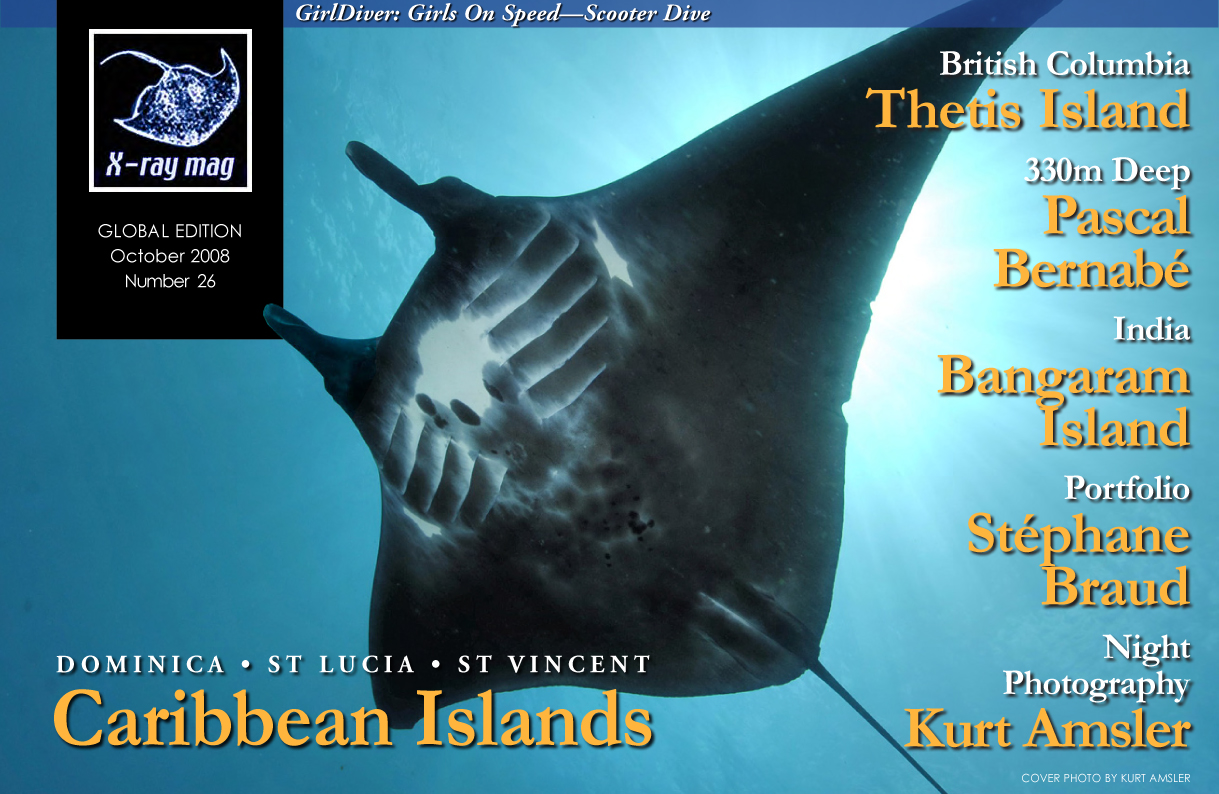Hollywood blockbuster Mission Impossible III shows Ving Rhames diving beneath the Vatican on an XScooter DPV to save Tom Cruise from the prison below. Now, GirlDiver takes a look at the XScooter Dive Propulsion Vehicle (DPV) from a gentler perspective. Serious DPV diving for a girl? Is it too big? Too powerful?
Contributed by
In the world of diving, we have the necessary gear, and we have fun accessories. The accessories of diving are used to enhance your diving experience, as fashion accessories are used to enhance your clothing selections.
There is a difference in designer handbags, as all women know. You’ve got the limited edition Prada bag versus the Coach purse at the local fine department store. One purse will cost thousands, whereas the other handbag, mere hundreds. And regardless of whether or not you’re a purveyor of costly handbags, you’ve probably got a girlfriend or an office mate who will argue the legitimate value and pricing of their high-end purses.
There is the attention to detail, the usability, the size and the length of time one would expect the handbag to last with daily wear and of course, the materials of which the bag is made.
Dive propulsion vehicles
The scooters of the sea definitely fall into the accessory category. Not needed, but as an enhancement to your diving experience, they can ease the effort and reduce the amount of air you breathe during a dive, as well as zip you out to a dive site without a lengthy surface swim. You can survey a wreck at depth, flying over the ship like an astronaut strapped to a rocket pack in space. Probably not a vehicle you’ll be using on every dive, but one brought out on special occasions to add to the dive event.
I was invited by the makers of the XScooter, Ben McGeever and Andrew Georgitsis, to take their super lightweight DPV for a spin.
Already familiar with scooters having a much lower price point, I was excited to try a higher end— “designer”, if you will—DPV.
Was there really a difference? Would the attention to detail, usability, size and length of time one would expect the model to last justify the cost difference? And known more in technical diving circles than recreational, would I, as a recreational GirlDiver, be comfortable on the unit, built for tech divers slinging extra tanks on their sides in addition to the doubles on their backs?
At the manufacturing facility, I was shown the process for making the scooter. A computerized lathe carves the cone from solid bullets of aluminum, to keep the vehicle light, the seams are welded, sanded and sent out for paint. A 60-pound thrust, brushless motor is added, with a variable pitch propeller system, to complete the most powerful machine in its class. To add to the machine, underwater camera mounts, compass mounts and light mounts can all be incorporated to fit the diver’s needs.
Originally, I had thought of trying out the Gavin, the beefiest of sea scooters. Ben offered to let me try the model they owned. However, after trying to lift the 78-pound behemoth, I decided the weight alone would realistically dissuade me from using the DPV very often.
I thanked the guys for the offer, but today I would simply try their XScooter. I could carry the 35 lb/15 kg unit to the water myself.
At the beach, technical dive instructor and videographer, Laura James, met me to introduce me to the XScooter. A small female, she also owns the Gavin, though admits to not using it often, as the weight of the scooter tends to keep it at home when packing for a day of diving.
When Laura started diving her XScooter, the manufacturer had designed a smaller handle for her girly hands, however, she found the standard handle was a good fit as long as you’re allowing the harness set up to pull you, not your arm. The DPV is attached to the diver on a d-ring clip at the waist, so manhandling the single handle was unnecessary.
I tried to allow myself to relax into the scooter, allowing the waist attachment to pull me, although it seemed counter-intuitive to not holding the handle tightly. However, if this is the biggest learning curve, it’s easily overcome.
Underwater, the scooter really showed its capabilities. Not only was I able to power out to a site, but I could easily control the depth and wasn’t worried about making too quick of an ascent to the surface, as it was absolutely neutral in the water. When I found something to look at, I simply dropped the scooter from my hands, it turned off and floated beside me. Dangling in the water, the machine was not cumbersome. In fact, I barely noticed it was there while looking at anemone encrusted pilings.
The underwater ballet aspect was the best part of the dive. Hearing the music of a symphony in my head as I turned spirals and pirouettes in the water. Feeling absolutely free, without a need to kick and really being one with the water and the scooter. I can see the addiction scooter owners have as I moved effortlessly through anemone covered pilings, navigating easily with a movement of the fin or a twist of my arm.
I found having one arm free allowed me to frequently check my gauges, which allows for better safety on the dive. The compass mounted on the DPV also made navigation easy, as we headed out to deeper waters. While we stayed well above the depth limit for recreational divers, the XScooter has a depth rating of 600ft/180m.
As a school of piling perch crossed in front of us, I joined in their flight. The XScooter travels at a top speed of 200ft/60m per minute, so the ability to travel the same speed as the fish gave a new wonderment to swimming in the mass. Imagine swimming with seals, mantas or whale sharks —yet another benefit of the scooter.
At exactly 50 lbs/23 kg, the DPV plus hard rolling case, is within the weight limits for checked baggage on most commercial airlines. This allows the toy to be a part of the next dive holiday, where more ground can be covered on new dive sites. While the toy will take up one piece of luggage, on holiday, you just need a few pieces of beach clothing, as you’ll be enjoying the underwater realm with new found freedoms.
Whether stepping up to a “designer” DPV, or going with a lower priced model, the DPV is definitely a fun accessory to add to your dive locker—maybe not for every dive, but for the ones where you’d like a little more bottom covered, a bit less air used and the exhilaration of effortless speed.
With the lower end scooters, you should expect less power. They fall into a “diver assist” category. The higher end scooters designed for the technical dive sector are true underwater propulsion vehicles. It’s the difference between a land scooter (moped) and a motorcycle. The motorcycle is more of a machine, and when you want the power and the speed, it’s worth the extra money.
Is the DPV too big for a girl? No. Today’s lightweight and powerful, yet highly maneuverable DPVs are definitely just as suitable to be a girl’s toy, as they are boy’s. ■


































